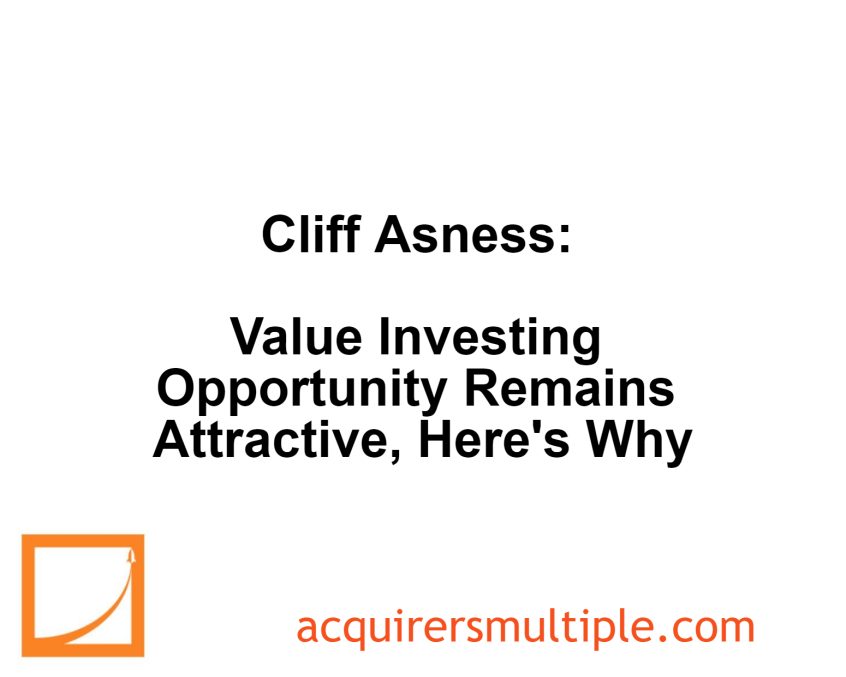During his recent interview with TD, Cliff Asness discusses a concept he’s developed: the magnitude of the difference between high and low multiple stocks. He believes that the greater the difference, the better the opportunity for value investing. He points out that this difference reached a historic high in October/November of 2020 and has remained significantly above average since then.
Despite a difficult year for value in 2023, Asness believes the opportunity remains attractive due to the high magnitude of the difference. He acknowledges that this spread could narrow but believes it still offers a good chance for outperformance.
Here’s an excerpt from the interview:
Cliff Asness – Sure. First, in the quantitative world, the academic world, value is, I think, kind of misnamed. It’s almost always price compared to some fundamental — price to book, price to sales, price to cash flow, price to earnings. To a Graham and Dodd old-school investor, that’s not value.
That number matters — they want to pay as little as possible. But it’s in context of the profitability, the growth opportunities, how risky it is, a set of other things. The funny part is this has caused all kinds of arguments between the two when they’re really doing the same thing. Quants and academics just have labeled this thing that I think probably should have been called the low-price factor, the value factor — and then they have a profitability factor and a low risk. They get to the same place, but huge miscommunication. So when I say “value,” I mean, do low multiple stocks beat high multiple stocks? On average, they do. You can do better than that incorporating these other things, but, on average, they do.
One thing you can measure, which no one had — I’m proud of this. We were the first to do this back in 1999, two or three bubbles ago — was no one, to my knowledge, had looked at the magnitude of the difference, meaning the standard academic approach was to stocks on your favorite measure of value, go long the low multiples and short the high multiples and see how well you did.
No one had, at least publicly, to our knowledge, had asked to the point, all right, but sometimes those multiples might be all pretty similar. And sometimes, they might be very different. And is the opportunity better when they’re different? We do find — and this could be argued, but we believe the opportunity is better when they are bigger differences.
Go to the opposite extreme. Imagine everything was priced to near the same. Not a lot of value opportunities going on. The biggest we ever saw that differential was March of 2000, it peaked, blew away prior ones. And then a few months after COVID, October, November of 2020, blew away March of 2000. So it was the 100th percentile.
I sometimes joke it was the 120th percentile. You’re laughing, I appreciate that, because a lot of people don’t get the joke because it’s a math joke. There is no 120th percentile. You’re just the new 100th. But what I convey with that is it’s substantially above the prior 100th percentile.
We have seen that number — it’s bumpy, some months it retreats, but it’s rather steadily come in for the last 3.5 years. Even last year, generally considered a very lousy year for value, was really about the Magnificent Seven. If you do value in a systematic way — 1,000 stocks that you like, 1,000 stocks you don’t like around the world — it was actually still a good year for value. Last I looked, which was about three days ago — so if anything radical happened while we started this, I may have to amend —
And I don’t mean to be overly precise, but we were down to about the 83rd percentile versus history. That’s not the same. We’ve come way down, because, remember, it was a new hundredth — it was way up there. So we’ve had a substantial move in that spread, but it is still, certainly, on the very wide side versus history.
So it could retreat. These are not short-term predictors. We don’t make giant calls on this. Even at the maximum, we did a rather small tilt to more value. We still like it. We still think it has a way to go. We would still do a little more value than you would normally do because that spread matters.
You’re getting a better deal than normal. The fact that we can have 3.5 really strong years, on net, not every month — for this value factor and it could still be the 83rd percentile is a testimony to how extreme it had gotten, where the starting point was really just — I don’t like using the word “crazy” too much about markets — Gene Fama, again, I’m a little nervous he’ll hear it and get mad at me, but I think it got pretty crazy by the end of 2020.
You can watch the entire interview here:
For all the latest news and podcasts, join our free newsletter here.
Don’t forget to check out our FREE Large Cap 1000 – Stock Screener, here at The Acquirer’s Multiple:



